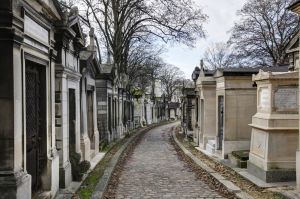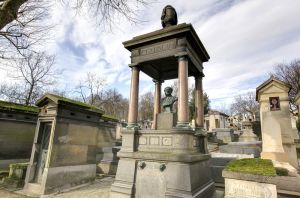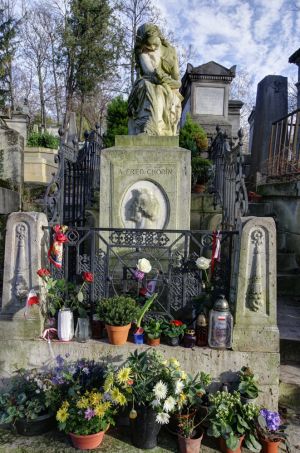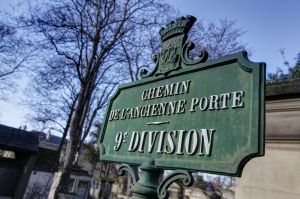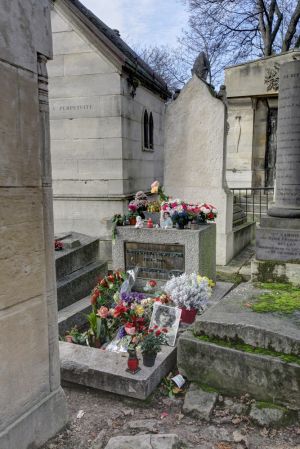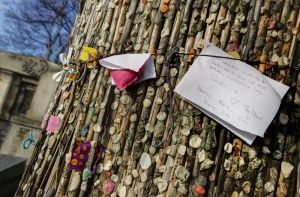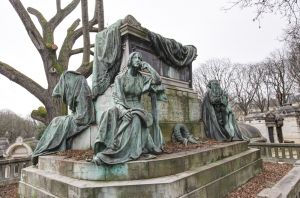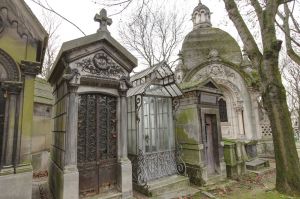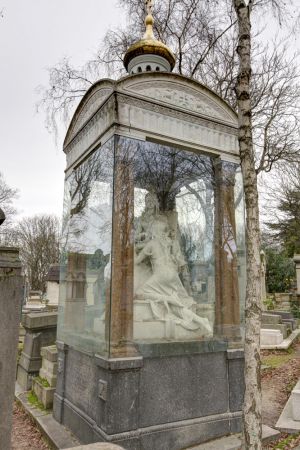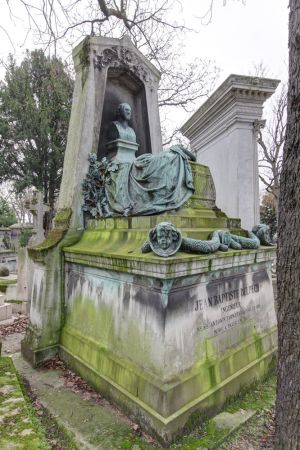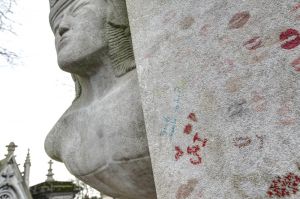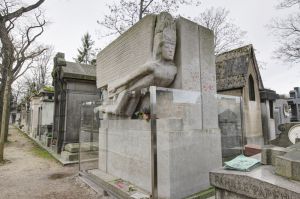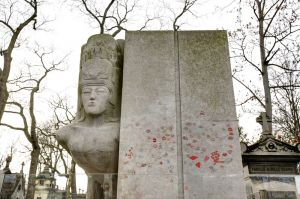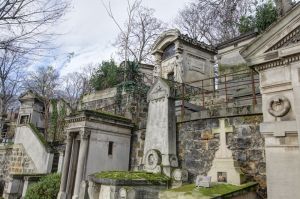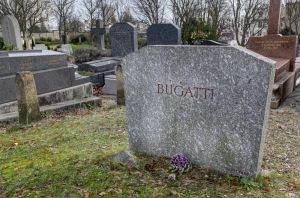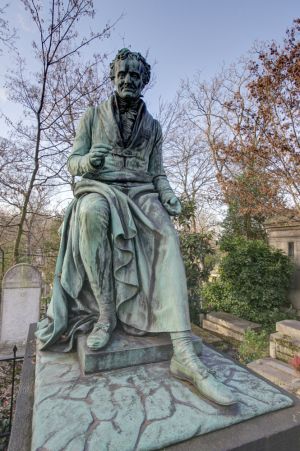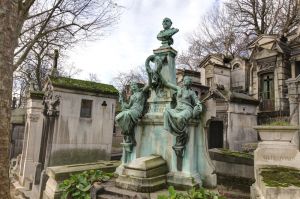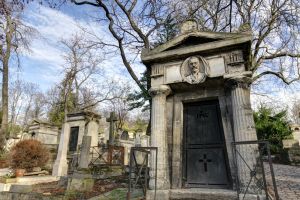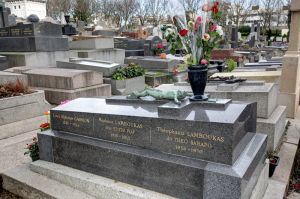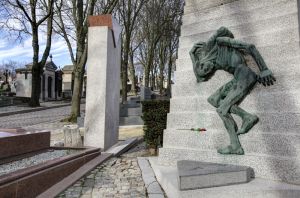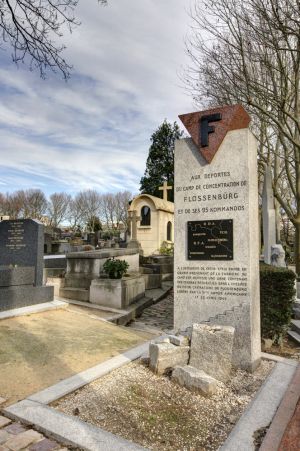The cemetery takes its name from the confessor to Louis XIV, Père François de la Chaise (1624–1709), who lived in the Jesuit house rebuilt in 1682 on the site of the chapel. The property, situated on the hillside from which the king watched skirmishing between the Condé and Turenne during the Fronde, was bought by the city in 1804. Established byNapoleon in this year, the cemetery was laid out by Alexandre-Théodore Brongniart and later extended.[citation needed]
As the city graveyards of Paris filled, several new, large cemeteries, outside the precincts of the capital, replaced them: Montmartre Cemetery in the north, Père Lachaise in the east, and Montparnasse Cemetery in the south. At the heart of the city, in the shadow of the Eiffel Tower, is Passy Cemetery.[citation needed]
Père Lachaise Cemetery was opened on 21 May 1804. The first person buried there was a five-year-old girl named Adélaïde Paillard de Villeneuve, the daughter of a door bell-boy of the Faubourg St. Antoine. Her grave no longer exists as the plot was a temporary concession. Napoleon, who had been proclaimed Emperor by the Senate three days earlier, had declared during the Consulate that “Every citizen has the right to be buried regardless of race or religion”.
At the time of its opening, the cemetery was considered to be situated too far from the city and attracted few funerals. Moreover, many Roman Catholics refused to have their graves in a place that had not been blessed by the Church. In 1804, the Père Lachaise had contained only 13 graves. Consequently, the administrators devised a marketing strategy and in 1804, with great fanfare, organised the transfer of the remains of Jean de La Fontaine and Molière. The following year there were 44 burials, with 49 in 1806, 62 in 1807 and 833 in 1812. Then, in another great spectacle in 1817, the purported remains of Pierre Abélard and Héloïse d’Argenteuil were also transferred to the cemetery with their monument’s canopy made from fragments of the abbey of Nogent-sur-Seine (by tradition, lovers or lovelorn singles leave letters at the crypt in tribute to the couple or in hope of finding true love).
This strategy achieved its desired effect: people began clamouring to be buried among the famous citizens. Records show that, within a few years, Père Lachaise went from containing a few dozen permanent residents to more than 33,000 in 1830. Père Lachaise was expanded five times: in 1824, 1829, 1832, 1842 and 1850. Today there are over 1 million bodies buried there, and many more in the columbarium, which holds the remains of those who had requested cremation.
The Communards’ Wall (Mur des Fédérés) is also located in the cemetery. This is the site where 147 Communards, the last defenders of the workers’ district of Belleville, were shot on 28 May 1871 – the last day of the “Bloody Week” (Semaine Sanglante) in which the Paris Commune was crushed
Cemetery today
Looking down the hill at Père Lachaise
Père Lachaise is still an operating cemetery and accepting new burials. However, the rules to be buried in a Paris cemetery are rather strict: people may be buried in one of these cemeteries if they die in the French capital city or if they lived there. Being buried in Père Lachaise is even more difficult nowadays as there is a waiting list: very few plots are available.The gravesites at Père Lachaise range from a simple, unadorned headstone to towering monuments and even elaborate mini chapels dedicated to the memory of a well-known person or family. Many of the tombs are about the size and shape of a telephone booth, with just enough space for a mourner to step inside, kneel to say a prayer, and leave some flowers.
The cemetery manages to squeeze an increasing number of bodies into a finite and already crowded space. One way it does this is by combining the remains of multiple family members in the same grave. At Père Lachaise, it is not uncommon to reopen a grave after a body has decomposed and inter another coffin. Some family mausoleums or multi-family tombs contain dozens of bodies, often in several separate but contiguous graves. Shelves are usually fitted out to accommodate them.
In relatively recent times, Père Lachaise has adopted a standard practice of issuing 30-year leases on gravesites, so that if a lease is not renewed by the family, the remains can beremoved, space made for a new grave, and the overall deterioration of the cemetery minimized. Abandoned remains are boxed, tagged and moved to Aux Morts ossuary, in Père Lachaise cemetery.
Plots can be bought in perpetuity, for 50, 30 or 10 years, the last being the least expensive option. Even in the case of mausoleums and chapels, coffins are most of the time below ground.
Although some sources incorrectly estimate the number of interred as 300,000 in Père Lachaise, according to official website of the city of Paris, one million people have been buried there to date.Along with the stored remains in the Aux Morts ossuary, the number of human remains exceeds 2–3 million.
